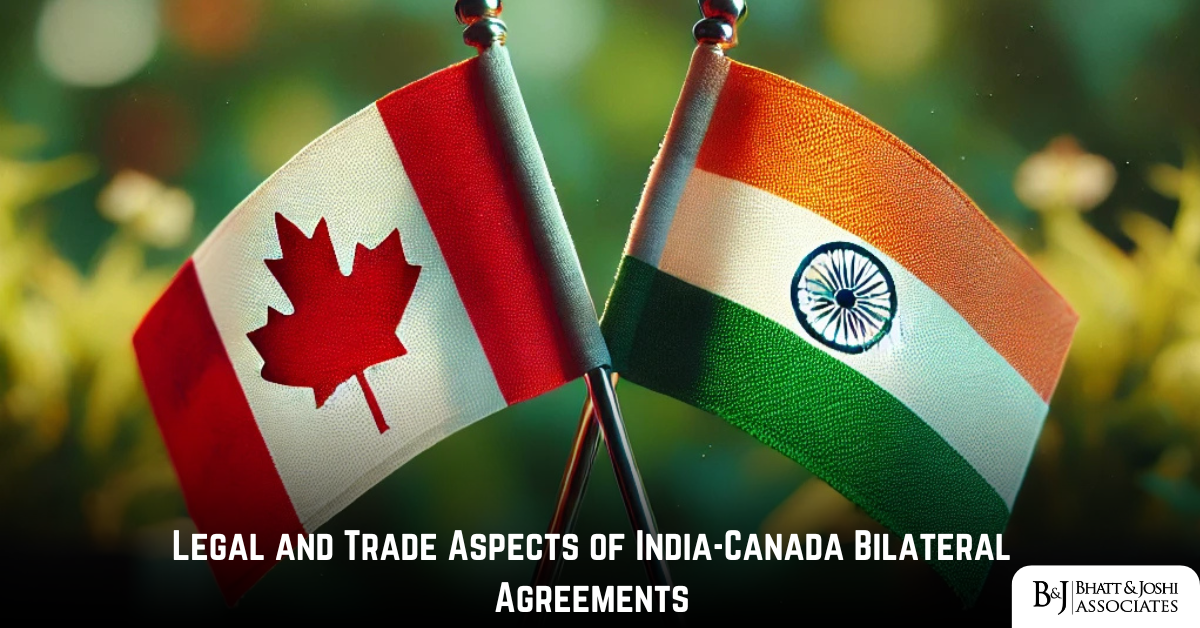Introduction
From the mid-20th century until now, the relations between India and Canada have remained multifaceted and strong, with diplomatic initiatives in trade, defence, technology, education, and energy. The United Nations, along with the World Trade Organization, are two of the many organizations both these countries are part of, further fostering these deep-rooted associations. These ties are further strengthened through India-Canada Bilateral Agreements, which provide a formal framework for cooperation across key sectors. Furthermore, the alliances between these countries are extensive and are covered under international law, domestic statutes, and case law. In this paper, the focus rests on the legal and trade aspects as well as their governance, which holds relevance at law and important judicial interpretations.
Overview of India-Canada Bilateral Agreements
The nations of Canada and India have previously ratified numerous treaties to enhance their collaboration. Major treaties include the Agreement on Air Transport, the Foreign Investment Promotion and Protection Agreement (FIPA), and the Comprehensive Economic Partnership Agreement (CEPA). These treaties are expected to stimulate trade and investment activities along with the transfer of goods, services, and intellectual property between the nations. The treaties seek to improve economic relations while fostering joint activities in technology, agriculture, renewable energy, and education.
Collaborative activities with the two nations aim at removing barriers to free trade, limiting the scope of legal interventions that protect investors, and increasing competition. Most of these treaties incorporate standards of openness and mutuality so that both countries’ investors and businesses operate without discrimination. Also, an agreement on settlement of disputes through arbitration or other ways is made and so on. With accompanying sectoral treaties of the basic treaties, it is possible to identify the relevant ones with education, agriculture, and energy which reflect the complexity of the relationships India and Canada have.
Regulatory Framework Governing India-Canada Bilateral Agreements
International Regulations
The bilateral agreements between Canada and India are impacted by several laws and international treaties, such as the WTO treaties where both nations are members due to its provisions on trade relations, tariff implementation, and resolution of conflicts. The General Agreement on Tariffs and Trade (GATT) and the General Agreement on Trade in Services (GATS) have a considerable impact on trade agreements made between Canada and India. Such agreements expose other state parties to the contracts to their duties and offer multi-lateral conditions that ensure their bilateral obligations are carried out as per the stipulations set in the international arena.
These agreements often have arbitration and dispute resolution provisions that follow the United Nations Commission on International Trade Law (UNCITRAL) guidelines. Further, the treaties set on the scope of international relations also set the default provisions on property rights such as The Agreement on Trade-Related Aspects of Intellectual Property Rights (IPR) treaties aid in establishing IPR statutes under international cooperation. Such approaches by Canada and India can foster an environment that is free and safe for trade and investment.
Domestic Laws
While bilateral agreements in India are regulated by the Constitution, specifically Article 246 which contours the scope of the Union and State legislatures, international treaties require Parliament’s consent before enforcement as highlighted in Article 253. The Foreign Exchange Management Act (FEMA) of 1999 and the Arbitration and Conciliation Act of 1996 are important bilateral trade agreements’ primary domestic legislation counterparts. These statutes ensure that India’s global obligations are appropriately transformed into legally binding domestic obligations.
In Canada, the execution of treaties is premised on the principle of dualism, which requires legislative action for a treaty to become effective domestically. Trade and investment treaties with India fall within the purview of the Canadian Constitution and laws like the Investment Canada Act and the Canadian International Trade Tribunal Act. This dualist approach guarantees that foreign national documents are made subject to careful examination before becoming part of Canadian law to ensure that international commitments are not given more importance than domestic needs.
Trade Relations and Economic Implications
The trade relations between the two nations have had a positive track record over the years, with each country reciprocating in the exchange of products and services. India’s chief exports to Canada are textiles, pharmaceuticals, and information technology services, while Canada exports agricultural products, minerals, and energy resources to India. The ever-increasing diversification of trade portfolios is a reflection of the complementarity of the two economies and their potential dynamic growth.
Bilateral treaties like the FIPA have been instrumental in enhancing foreign direct investment. Take, for instance, the Canadian pension funds that have greatly invested in Indian infrastructure and real estate projects. Such investments do not need to worry about host country legal bias because they are safeguarded through bilateral treaties that guarantee the investor’s right to equal treatment and protection from expropriation. Likewise, Indian business entities have invested in the technology and resource sectors in Canada, aided in employment generation, and economic growth in both nations.
Another area of cooperation that is important in the trade relations between India and Canada is the exchange of students and teachers. Education has become one of the major industries in Canada owing to the increased enrollment of Indian students in Canada’s higher education institutions. This relationship has been fostered further by treaties that encourage partnership in educational institutions and the recognition of academic qualifications.
Legal Provisions and Dispute Resolution
Bilateral agreements tend to include clauses on dispute settlement to facilitate the flow of trade and investment. Such provisions are normally conducted under international arbitration procedures, like those of the International Centre for Settlement of Investment Disputes (ICSID) or UNCITRAL. The presence of effective mechanisms for resolving disputes demonstrates the willingness of both states to provide a stable and predictable business environment.
In India, the Arbitration and Conciliation Act of 1996, which came into force in 1996, defines arbitration terms and conditions. It is one of the legal instruments which brings domestic law into compliance with international law. Likewise, Canada’s Arbitration Act enables the settlement of disputes arising out of bilateral contracts. The mechanisms for settlement of disputes are essential for unbalanced trade, breach of contracts, and violation of investment protection terms. Giving priority to arbitration enables disputes to be settled in a manner that does not adversely impact trade relations.
Case Law on India-Canada Bilateral Agreements
Multiple cases have litigated the construction and execution of India-Canada bilateral treaties. One noteworthy example is the White Industries Australia Limited v. Republic of India case, which while concerning an Australian party, underscored the role that bilateral investment treaties play in providing effective means for dispute resolution. In this case, the jurisprudence of the enforcement of arbitral awards was liberalized about the Australia-India agreements. Thus, it was made necessary to comply with the arbitral awards promptly.
Another case is Methanex Corporation v. United States, under NAFTA, which case also modified the other treaty formulation concerning the protection provisions of investors, including India and Canada. These examples illustrate the case law context within which the bilateral treaties are negotiated and executed.
Challenges in India-Canada Bilateral Agreements
Despite achieving some level, India and Canada face many obstacles in the implementation and management of their bilateral relations. Other barriers include discrepancies in protectionist measures, regulatory standards, and the stalemate in the closing of cover agreements, for instance, the CEPA. In addition, controversies about copyright and trade mark violations and labour standards have on some occasions cooled business activity. These factors underline the necessity for the two nations to continue their consultations to close the divergencies.
The approach of the Indian judiciary regarding the enforcement of international arbitral awards disputes has equally been contestable. An instance is the Nafed v. Alimenta S. A. case, where the Indian Supreme Court declined enforcement of a foreign arbitral award on behalf of the Indian party on the grounds of public policy. Such cases serve to show the difficulties in implementing domestic legislation with international obligations. In the same way, Canada’s foreigners’ investment pourous policies have had some of Indian businessmen thinking they are too protective.
Recent Developments and Future Prospects
Some recent highlights in the relationship between India and Canada are the ongoing parleys to achieve closure on the CEPA, which seeks to facilitate investments and trade by lowering tariffs as well as non-tariff barriers. Both countries have also shown willingness to work together on green energy projects such as renewable energy and carbon capture technology. These steps show a joint understanding to deal with international problems like climate change and energy security.
The provisions on digital trade and e-commerce are likely to deal with new gaps within the digital economy. Instrumental provisions such as data protection and cross-border data flow as well as cybersecurity will likely become basic features of bilateral treaties so that both nations can remain relevant in the international digital economy.
Also, both countries seem to be willing to expand collaboration on artificial intelligence, cybersecurity and climate change. The heightened attention on innovation and technology will augur well in deepening economic and strategic relations. There are also expected to be greater humanitarian and people-to-people engagements that will contribute to building goodwill and understanding.
Conclusion
The legal and trade dimensions of India-Canada bilateral agreements show a dynamic and evolving relationship. Although some issues like policy drifts and regulatory gaps need to be worked on, they do help other laws and policies in place, and so do these agreements. The prospect for propelling economic development and strengthening bilateral relations is quite encouraging with continuous discussions and new fields of collaboration in sight. Realizing the full scope of this partnership will highly depend on the dedication towards maintaining international standards and reinforcing institutional frameworks.














